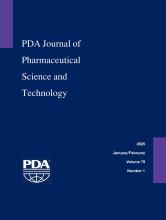Abstract
Container closure systems that are used for packaging pharmaceutical products are required to satisfy numerous safety requirements. Maximum permitted limits on the concentrations of numerous toxic elemental impurities that potentially leach from the packaging are one such requirement. The implementation of ICH-Q3D Guideline for Elemental Impurities, in conjunction with the 2018 publication of USP General Chapters <232> Elemental Impurities - Limits and <233> Elemental Impurities - Procedures, requires a critical risk assessment of all container closure systems to evaluate their contribution of certain elemental impurities to the enclosed drug product. ICH-Q3D has established limits for each specific elemental impurity that considers relevant toxicological data and administration route (oral, parenteral or inhalation) and presents them as permitted daily exposures based on the maximum daily dosage of the final drug product. A study was undertaken to assess the degree of elemental impurity leaching from one type of pharmaceutical glass vial under specific, fixed environmental controls. Multiple buffer systems representing a broad spectrum of possible parenteral drug product formulations were used in the study. Resulting buffer solutions that had been in contact with a single type of glass vial under specific conditions were subsequently analyzed using an inductively coupled plasma-mass spectrometry method developed and validated specifically for the purpose of quantifying elemental impurity leachables in a variety of parenteral formulations. Results indicated that the degree of elemental impurity leachables imparted by the specific type of glass vial evaluated during this study pose no risk to patient safety, regardless of the drug product buffer formulation. Following this evaluation, the ICP-MS method developed for the determination of elemental impurities leachables has been successfully applied to the assessment of elemental impurities in a number of different biological parenteral drug product formulations currently under development. This data can be leveraged for inclusion in elemental impurities component ICH-Q3D risk assessments to satisfy the container closure system contribution.
- Received May 10, 2021.
- Accepted September 21, 2022.
- Copyright © 2022, Parenteral Drug Association
PDA members receive access to all articles published in the current year and previous volume year. Institutional subscribers received access to all content. Log in below to receive access to this article if you are either of these.
If you are neither or you are a PDA member trying to access an article outside of your membership license, then you must purchase access to this article (below). If you do not have a username or password for JPST, you will be required to create an account prior to purchasing.
Full issue PDFs are for PDA members only.
Note to pda.org users
The PDA and PDA bookstore websites (www.pda.org and www.pda.org/bookstore) are separate websites from the PDA JPST website. When you first join PDA, your initial UserID and Password are sent to HighWirePress to create your PDA JPST account. Subsequent UserrID and Password changes required at the PDA websites will not pass on to PDA JPST and vice versa. If you forget your PDA JPST UserID and/or Password, you can request help to retrieve UserID and reset Password below.






